Moving Cows
Moving Cows with Farmer Fred July 2017
The video is of the smallest move we make, from one side of the yard to the other.
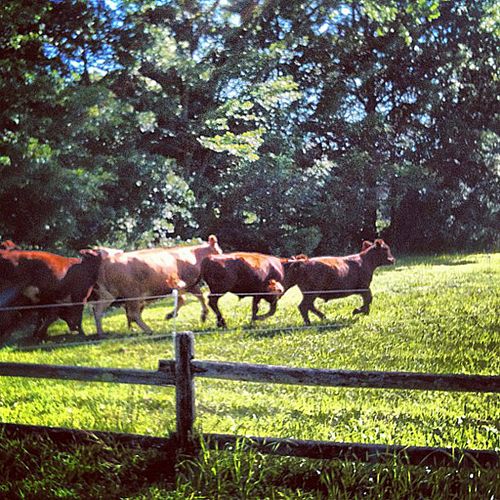
The ¾ mile run
On our farm the cows are moved daily or every other day. These moves can be as small as from one internal paddock within a pasture to the next paddock, or nearly ¾ of a mile away.
The way we determine when to move is by the height of the grass, and the way it is growing. If we are in a drought, as we were in 2016, they move much faster as we don’t want to overgraze ever.
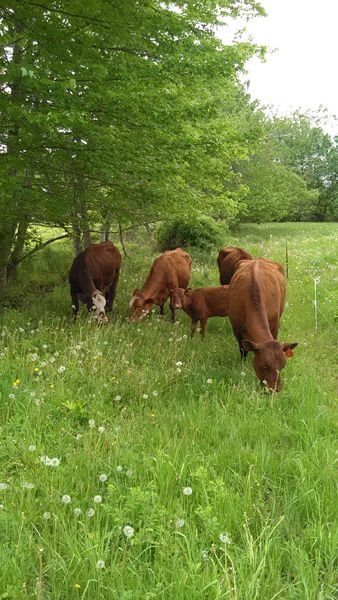
Cows on the aisle at the 10 acre piece
We try to keep the grass at a height of not less than 8” to prevent too much root pruning. When grass is grazed and the tops removed, the plant prunes the roots to the new size of the plant. This is one of the ways grazing puts organic matter into the soil.

Our farm and the 2 pieces we lease are long thin strips of ancient tobacco land. We have 3 pieces of land we run the cows on: our farm with 5 acres of pasture (red outline), a 10 acre piece on a farm 2 doors down (white and also light green outline), and a 2 acre piece across the street. None are adjoining our farm. The land between us and the 10 acre piece belongs to a neighbor who is not neighborly. So we must go around.
The Long Runs
As an older, disabled couple we’ve developed a method of moving the cows that does not result in cow chases through town. We use pigtail posts and polywire.
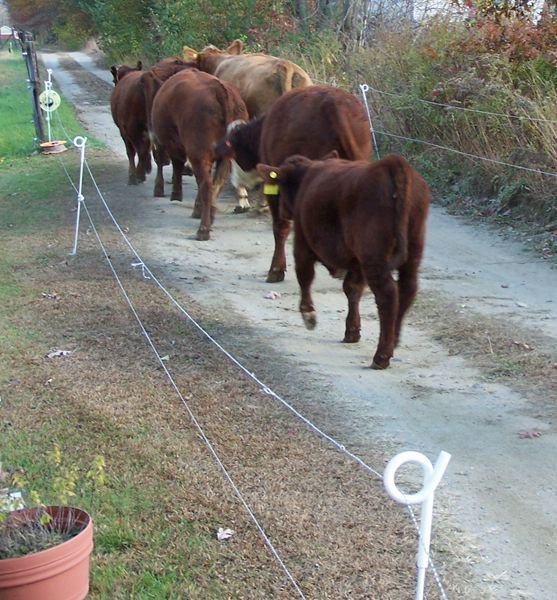
The end of the shortest run
It takes a while to set it all up and take it all down but the energy required is nothing compared to a wild chase through town, or woods, or down the highway.

The longest run, nearly ¾ mile
The longest run starts behind our barn on the back 40. This is the end of a cycle through all the pastures. They will be returning to the start of the cycle: the aisle on the 10 acre piece. The route: down our ¼ mile driveway, across the road, down the road, across the road, and down the driveway to the 10 acre piece, nearly ¼ mile.
Moving Cows across the Road
This is fenced in completely, even the road crossings. They are designed to be closed when the cows are released, and easily moved once they are in the pasture again. Traffic can be stopped for up to 15 mins. We make this run at least twice a season. We also do shorter versions, to the 2 acre piece or just to our front pasture.
So any time we move the cows outside the perimeter fences, we set up the pigtails and polywire. We’ve created sets of all the reels of wire needed and noted the number of posts needed to make any one of the runs from certain spots on all the properties. Depending on the length of the run, it can take an hour for a complete move or several hours.
Daily Moves

The green lines show the lanes for each pasture
We also do daily moves as we very carefully manage the height of the grass when they are grazing. It is crucially important that it not be grazed lower than 8”, as the root die off is too extreme and the grass does not re-grow properly.
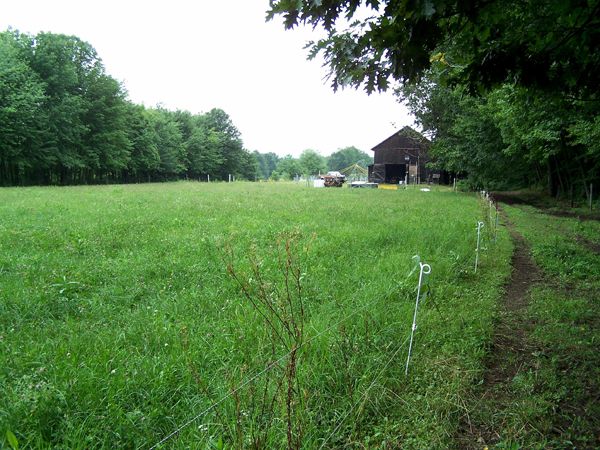
Aisle on right, in the back 40 pasture
We use the pigtails and polywire for internal fences, all coming off a main aisle down one side of our long narrow property. Our property is only 160’ wide, long thin tobacco land. Because of this we have to resort to a lane to provide an area the cows can get to water, to their mineral, and to shade.
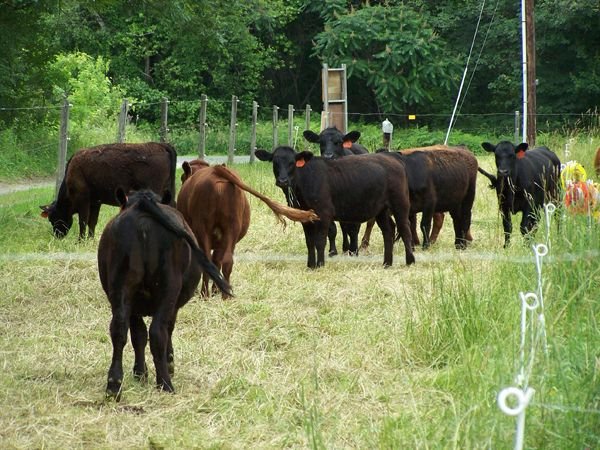
The aisle in the front pasture
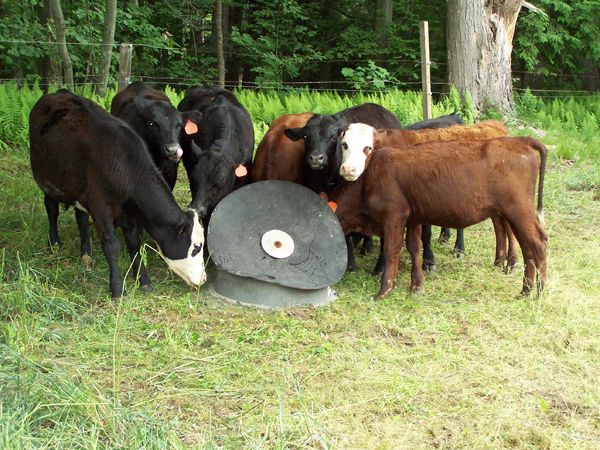
Cows at the mineral feeder at the end of the back 40 aisle
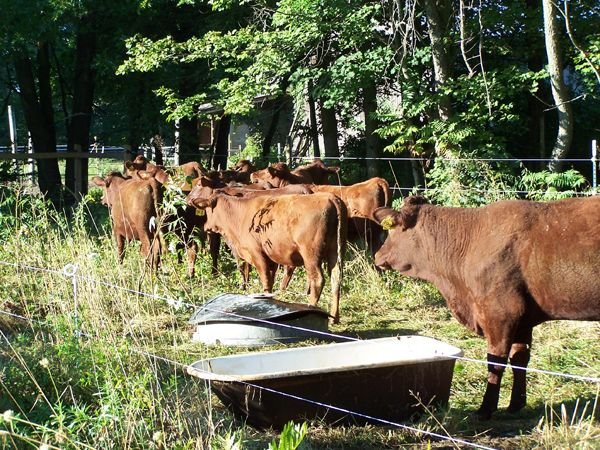
Cast iron tubs for water and the mineral feeder in the aisle area at the 10 acre piece
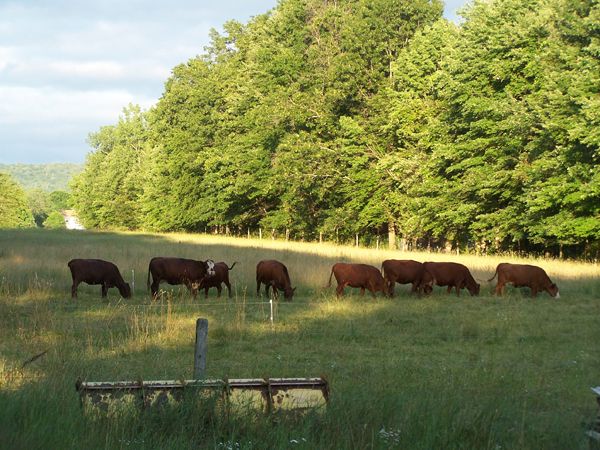
In this photo, you can see in the foreground the paddock they just left, the one they are on for the night, and the grass they will go on the next day. The paddocks generally are 40’ wide. (Perimeter fence posts are 20’ apart.) But if the grass is really high, they can drop to 30’ or if it’s very thin or drought conditions, go up to 60’ or 80’ wide.
Winter Management
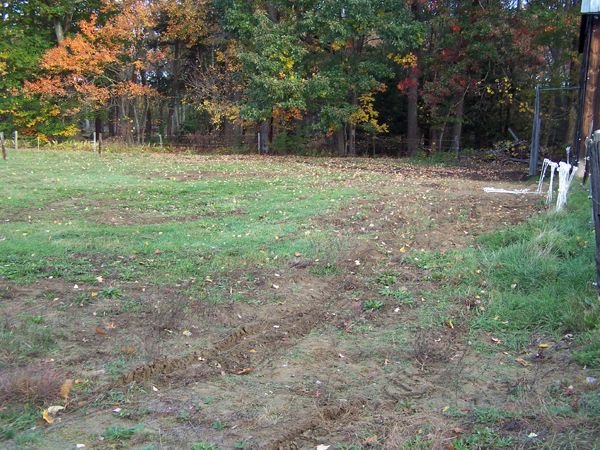
Turnout on the West end of the barn
We set up the pastures and turnouts so the pastures would be protected from December to May from grazing. But animals need room to move even if they aren’t grazing. So we allocated ¼ acre on 2 sides of the barn as sacrifice areas, areas that would be ruined by having animals on them in winter. We used these areas when we had cows over the winter. Now we use them for the pigs and layers.
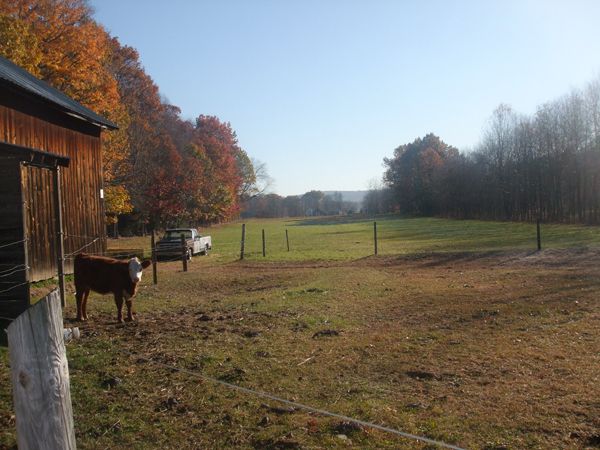
Turnout on the south side of the barn
Getting Cows Ready to Load on a Trailer
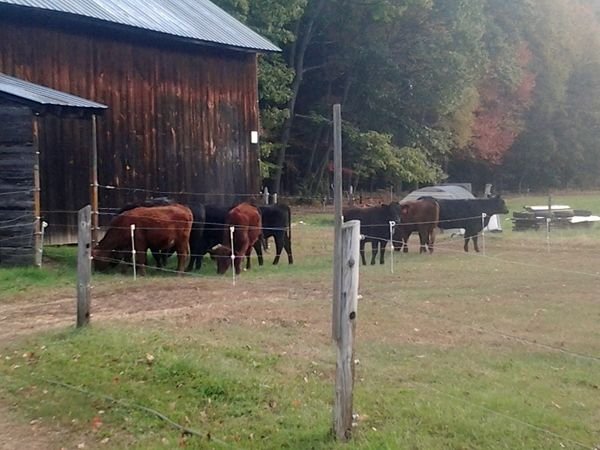
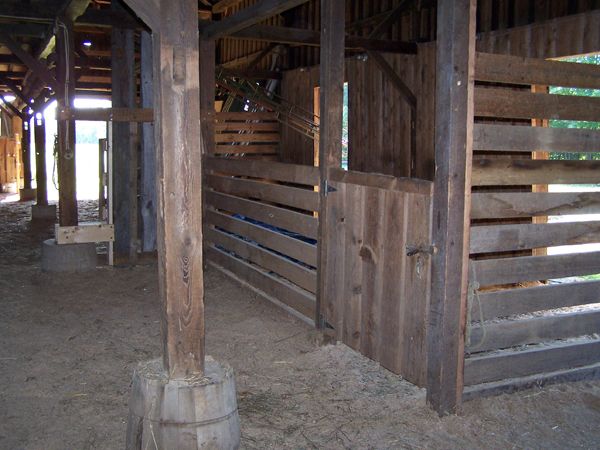
The inside stalls with the outside doors open
We have large stalls inside the barn on the south side. To provide access to them from outside, we cut doorways.
When we started doing custom grazing, we had to figure out a way to load the cows onto a trailer at the end of the season. We could not afford to build a special gather area and loading chute. So this is what we did.
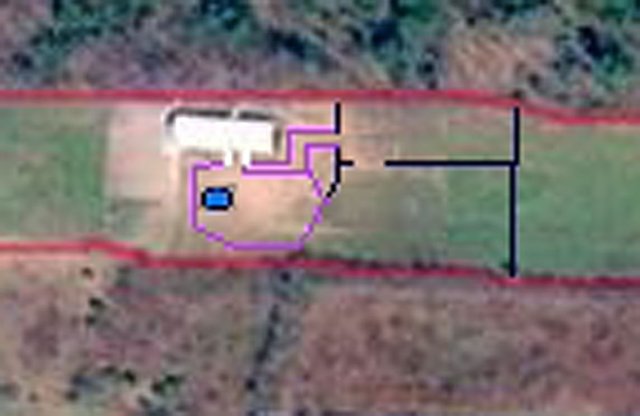
The black lines are the paddock fencing. The pink lines are the pigtails and polywire aisles. The blue dot is the water tub.
The idea is they can reach pasture OR water but not both. To reach one or the other, they MUST go through the stall in the barn. We start teaching them this about 5 days before they need to load on the trailer.
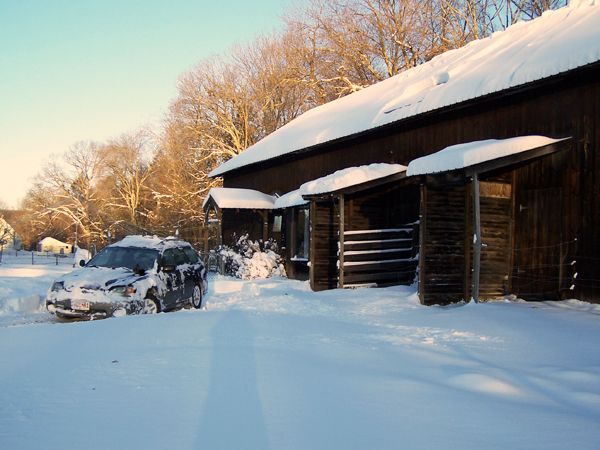
This photo shows the 2 windbreaks. The one with the bars is the loading chute.
With a metal roof, the snow comes off heavy and hard, so we built windbreak/shelters to protect the animals in winter.
The top pink line in the diagram leads up to the first windbreak (on right) in the above photo. The cows can come to this opening but nowhere else. They must either go into the barn (they’ve never been in a barn) or turn around and go back to pasture. They can’t reach their water unless they go into the barn. (See first photo in this section, they are deciding if they will go into the barn…)
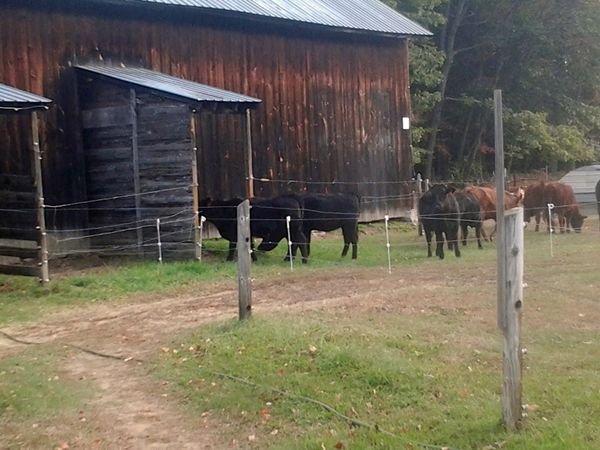
Once in the barn they cross the stall and can go out the loading chute/windbreak. They can now get to the tub to drink. To get back to pasture, they must again go through the barn, reversing their path.
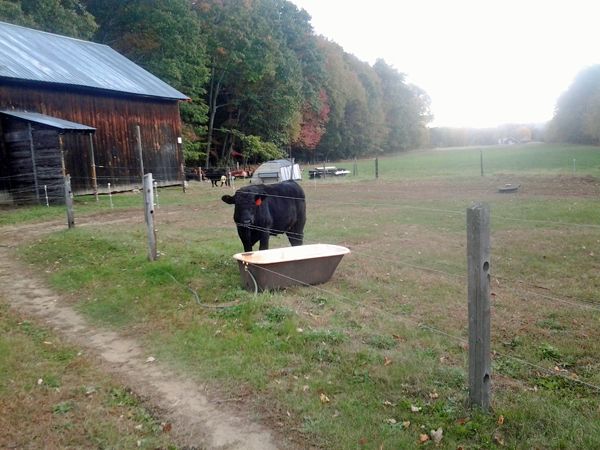
The point of this exercise is to keep the animals calm and stress free. When it’s time to load them, they are caught in the smaller of the 2 black areas on the diagram.
We open the fence where the tub is, back the trailer up to the loading chute, and slowly move the cows into the barn. To date, they have always just walked right out onto the trailer, only the second time on a trailer in their lives.
There’s no drama, yelling, or physical coercion. From the time they arrive, they learn to associate my husband with food and never with danger or upset. So we move them calmly from one place to another on a regular basis.
And that’s the way we work with all our animals, calmly and gently.
.jpg)

wow! cows!
(and having neighbors who are not neighborly is so frustrating!!)
They will arrive, we hope, sometime in the next 3 weeks....
The cows get to go on a day trip :D great post!
Very nice. I am lucky enough my property is all one connected piece but I am looking to buy property around mine and may end up in a situation like yours before to long. All my property connected has not keep me from having a wild cow chase though especially when we bring new cattle home. My red angus bull took about 5 hours to round up and a lot of it ended up being a foot chase threw the woods. Love the idea of the poly wire and it works well for our cattle that have been trained to electric but not so well on new cattle that have not. Look forward to the next cow move.
I love it. Glad to see someone else doing rotational grazing. Keep up the good work
A lot of great information! We do rotational grazing too, but with the extra cows I think we are going to eventually need to get more pasture set aside. They will sometimes eat it down a little more than we would like in a drought, but it always works out.
Looks familiar! Those hot wires are amazingly efficient. Our grasses still haven't come up like a normal spring yet.
Ours are just starting, really as of today, as we had 70F. To have 80's during the week, so the grass will take off.